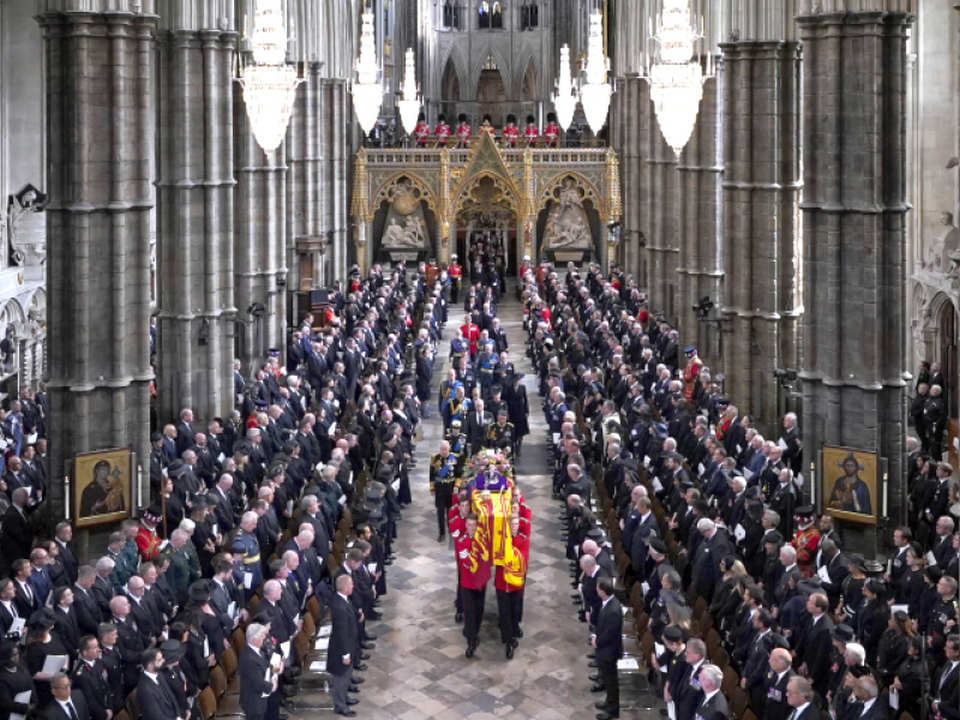
The State Funeral for Her Majesty The Queen took place at Westminster Abbey on Monday 19th September at 11am. The Funeral Service and the associated ceremonial arrangements paid tribute to The Queen’s extraordinary reign, and Her Majesty’s remarkable life of service as Head of State, Nation and Commonwealth.
The Funeral was broadcast live on TV, radio and The Royal Family’s Youtube Channel to allow people around the world to take part in mourning The Queen.
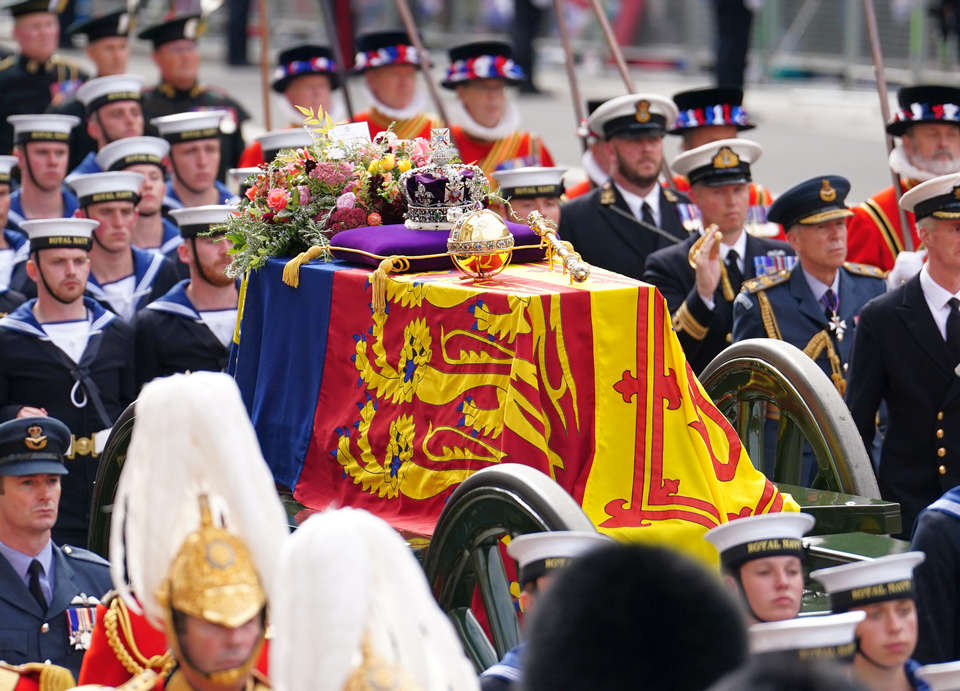
Procession from the Palace of Westminster to Westminster Abbey
The Queen’s Coffin had been Lying-in-State since the evening of Wednesday 14th September. At 6.30am on the morning of Monday 19th September, the Lying-in-State ended.
At 10.44hrs the Coffin was borne in Procession on the State Gun Carriage of the Royal Navy from the Palace of Westminster to Westminster Abbey for the State Funeral.
Immediately following the Coffin was The King, Members of the Royal Family and members of The King’s Household.
The State Funeral Service
The State Funeral Service was conducted by the Dean of Westminster and The Sermon and the Commendation were given by the Archbishop of Canterbury. You can read the Order of Service here.
‘Rarely has such a promise been so well kept’
The Archbishop of Canterbury today gave the Sermon at Her Majesty The Queen’s State Funeral: pic.twitter.com/EyIgSCjtVd
— The Royal Family (@RoyalFamily) September 19, 2022
During the Service, the Prime Minister and the Secretary General of the Commonwealth read Lessons. The Archbishop of York, the Cardinal Archbishop of Westminster, the Moderator of the General Assembly of the Church of Scotland and the Free Churches Moderator said Prayers. To mark the end of the Service, The Last Post sounded, followed by Two Minute’s Silence to be observed in the Abbey, and throughout the United Kingdom. The National Anthem drew the Service to a close.
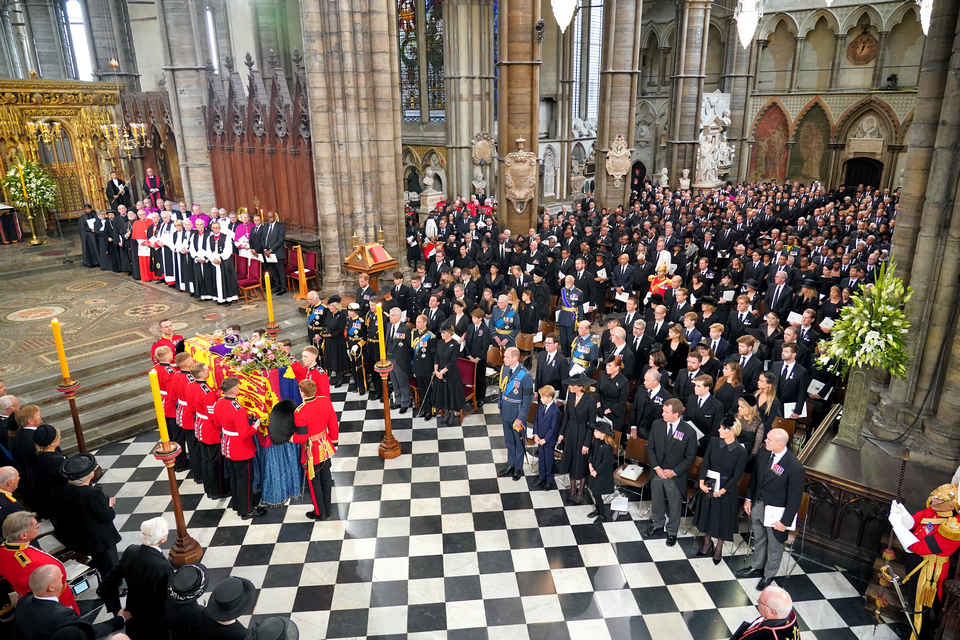
The State Funeral Service was attended by Heads of State and Overseas Government Representatives, including Foreign Royal Families, Governors General and Realm Prime Ministers. Other representatives of the Realms and the Commonwealth, the Orders of Chivalry including recipients of the Victoria Cross and George Cross, Government, Parliament, devolved Parliaments and Assemblies, the Church, and Her Majesty’s Patronages formed the congregation, along with other public representatives.
The Cavalry Last Post is sounded by the State Trumpeters of the Household Cavalry before the Nation fell silent in Remembrance of Her Majesty The Queen. pic.twitter.com/ap5ccCiQW2
— The Royal Family (@RoyalFamily) September 19, 2022
Almost 200 people who were recognised in The Queen’s Birthday Honours earlier this year also joined the congregation, including those who made extraordinary contributions to the response to the Covid-19 pandemic, and have volunteered in their local communities.
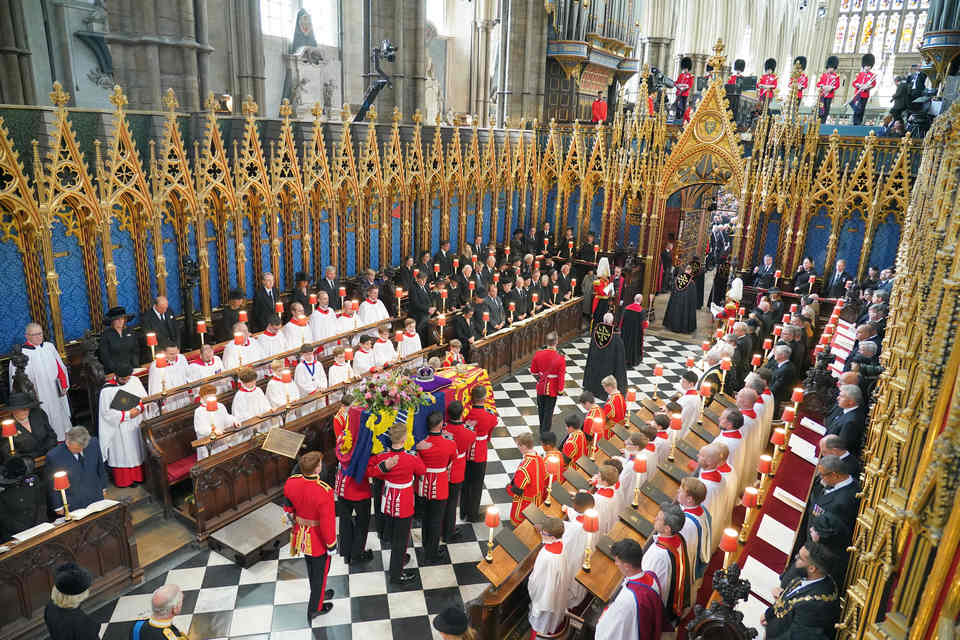 The Procession from Westminster Abbey to Wellington Arch
The Procession from Westminster Abbey to Wellington Arch
At the end of the Service, Her Majesty’s coffin was borne to Welington Arch, via The Mall on the State Gun Carriage.
As Big Ben tolled, Her Majesty The Queen’s coffin made its final journey through London.
From Westminster Abbey, along Horse Guards, down the Mall to Wellington Arch, the Procession included detachments from British and Commonwealth Armed Forces. pic.twitter.com/JYb4BZFeGZ
— The Royal Family (@RoyalFamily) September 19, 2022
Not seen on the streets of London since the funeral of Sir Winston Churchill in 1965, the State Gun Carriage was pulled by 98 Royal Navy sailors, with a further 40 marching behind acting as brakes. The King and Members of the Royal Family again followed The Queen’s Coffin in Procession. The Procession` include detachments from the Armed Forces of the Commonwealth, as well as detachments of the British Armed Forces who held a special relationship with The Queen.
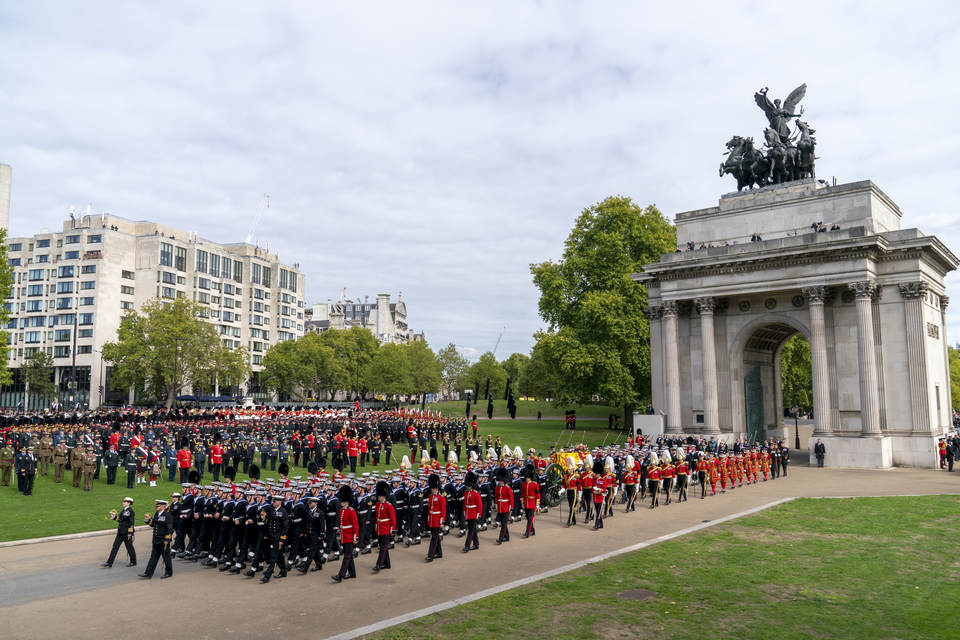
The King’s Guard gave a Royal Salute as the Coffin passed the Queen Victoria Memorial.
Once the coffin reached Wellington Arch, it was placed in the State Hearse. The parade gave a Royal Salute and the National Anthem played as the State Hearse began its journey to Windsor.
Procession from Albert Hall, Windsor to St George’s Chapel
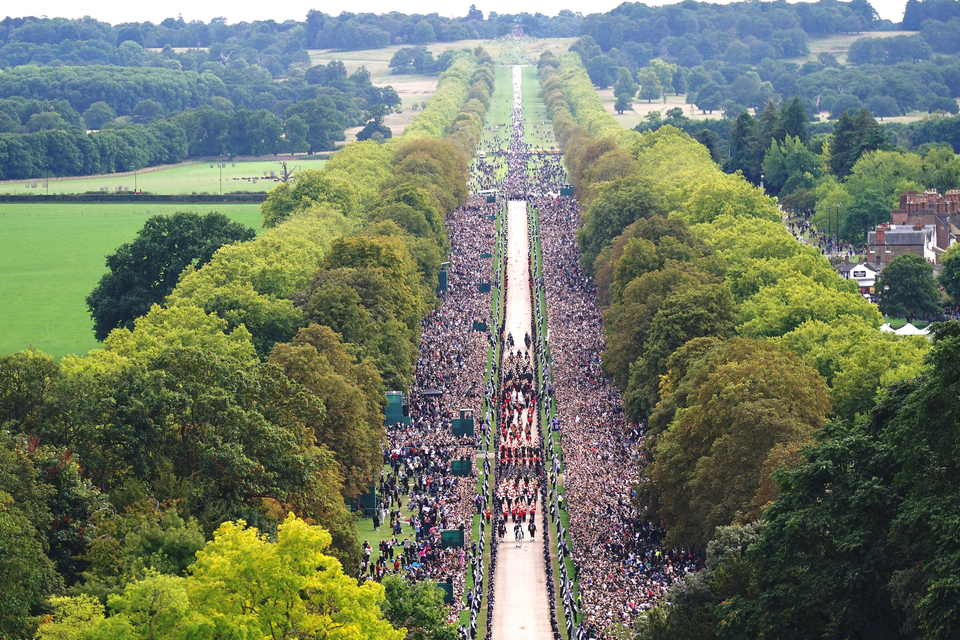
When the Coffin reached Windsor, the State Hearse joined a Procession formed up on Albert Road and travelled via the Long Walk to St George’s Chapel. Members of the Royal Family joined the Procession in the Quadrangle at Windsor Castle. Minute Guns were fired on the East Lawn, Windsor Castle by The King’s Troop, Royal Horse Artillery, and Sebastopol Bell and the Curfew Tower Bell tolled throughout the Procession.
Her Majesty’s fell Pony, Emma and her corgis, Muick and Sandy, were present as the Procession passed.
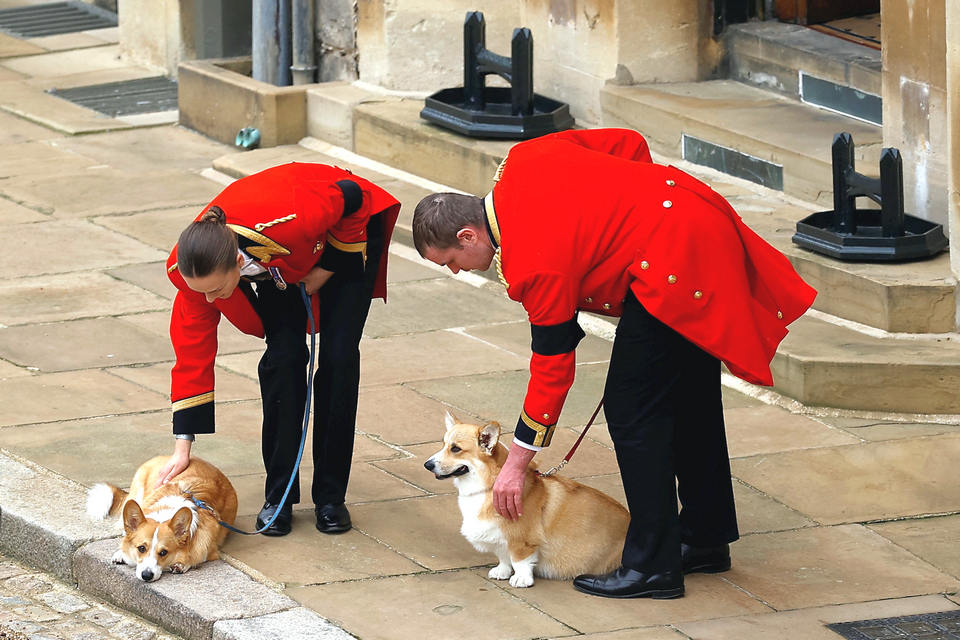
The Procession halted at the bottom of the West Steps of St. George’s Chapel where a Guard of Honour, found by the 1st Battalion Grenadier Guards, was mounted. The Queen’s Coffin was borne in Procession into the Chapel.
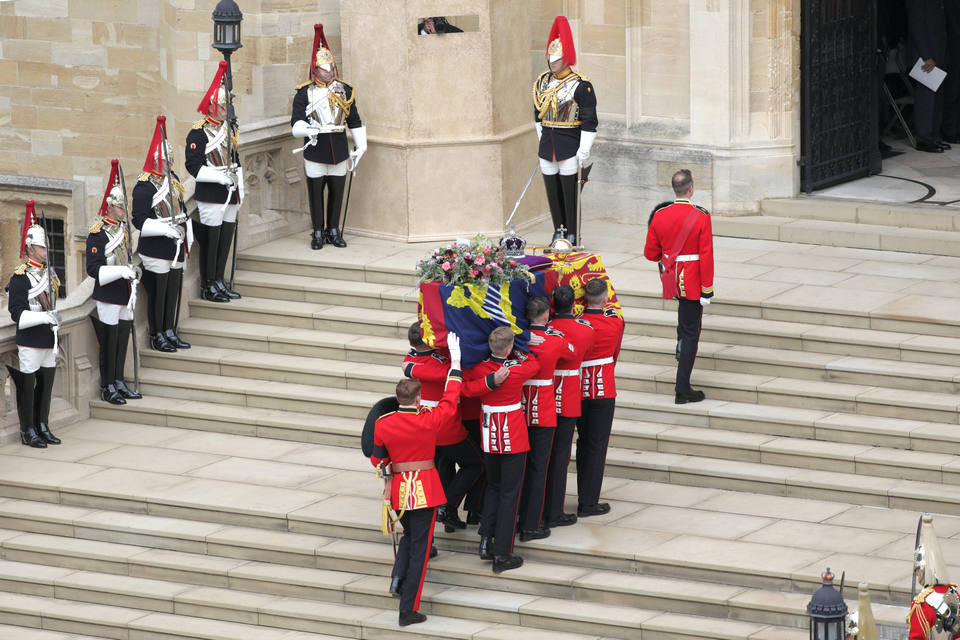
The Committal Service
The Committal Service began at 4pm, and alongside His Majesty The King and Members of the Royal Family, the congregation was made up of past and present members of The Queen’s Household, including from the private estates. Also in attendance were Governors General and Realm Prime Ministers. You can read the Order of Service here.
The Reading given by the Dean of Windsor, Revelation 21, verses 1-7, was also read at the Funerals of The Queen’s grandparents, King George V in 1936 and Queen Mary in 1953, and Her Majesty’s father King George VI in 1952.
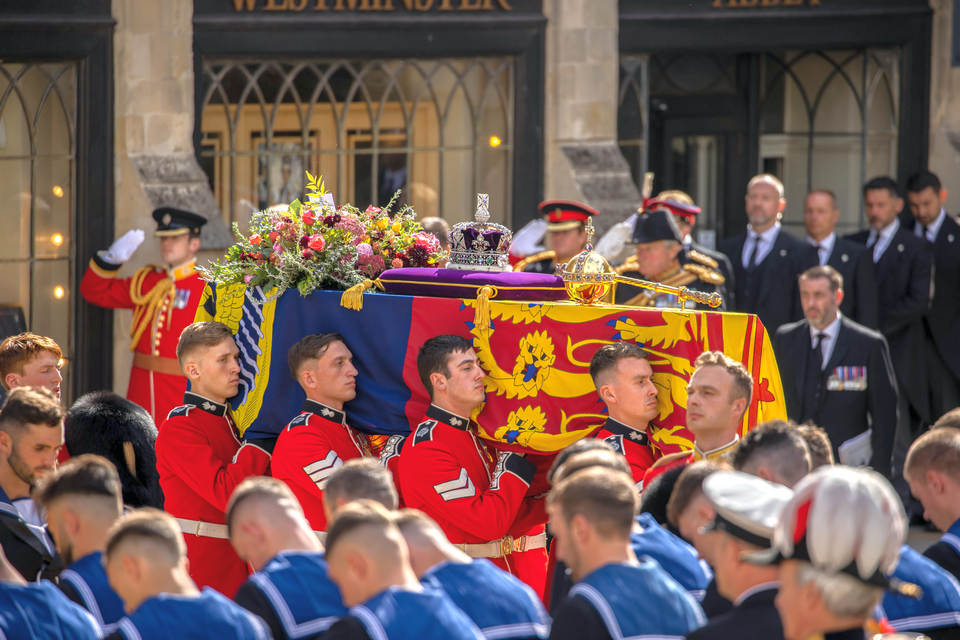
The Service was conducted by the Dean of Windsor, with prayers said by the Rector of Sandringham, the Minister of Crathie Kirk and the Chaplain of Windsor Great Park. The Choir of St George’s Chapel sang during the Service.
Much of the music at the Committal Service has been composed by Sir William Harris, who served as the Organist at St George’s Chapel between 1933 and 1961, for much of The Queen’s childhood. The young Princess Elizabeth would often visit the Organ Loft to watch Sir William play, and it is believed he taught her to play the piano.
Prior to the final Hymn, the Imperial State Crown, the Orb and the Sceptre were removed from Her Majesty The Queen’s Coffin, and placed on the Altar. At the end of the final Hymn, The King placed The Queen’s Company Camp Colour of the Grenadier Guards on Her Majesty’s Coffin. At the same time, The Lord Chamberlain “broke” his Wand of Office and placed it on the Coffin.
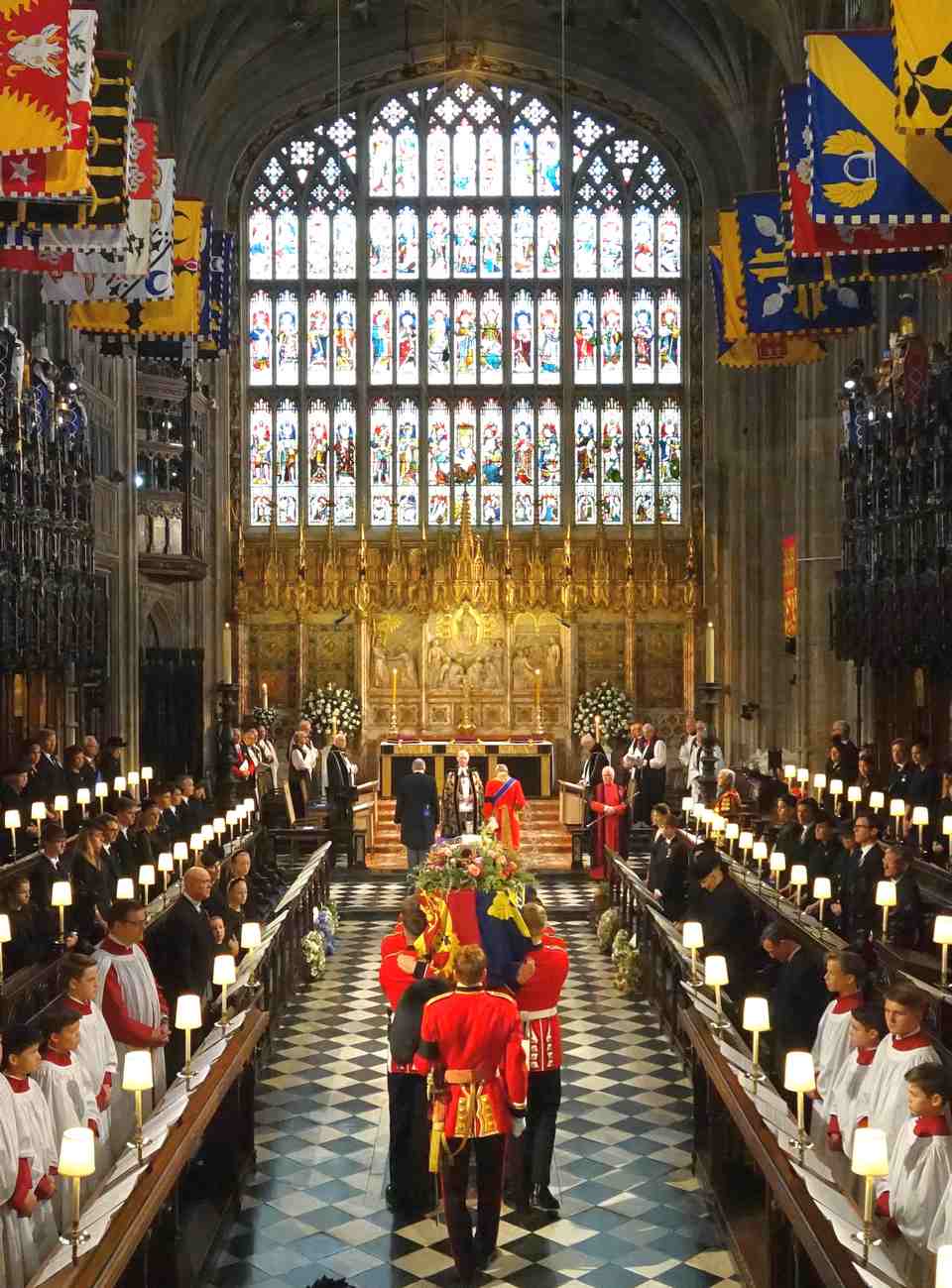
As The Queen’s Coffin was lowered into the Royal Vault, the Dean of Windsor said a Psalm and the Commendation before Garter King of Arms pronounced Her Majesty’s styles and titles. The Sovereign’s Piper played a Lament and The Archbishop of Canterbury pronounced the Blessing. The National Anthem was sung at the conclusion of the Service.
A Private Burial took place in The King George VI Memorial Chapel later that evening, conducted by the Dean of Windsor.
The Queen was buried together with The Duke of Edinburgh, at The King George VI Memorial Chapel.
 |
 |
 |





